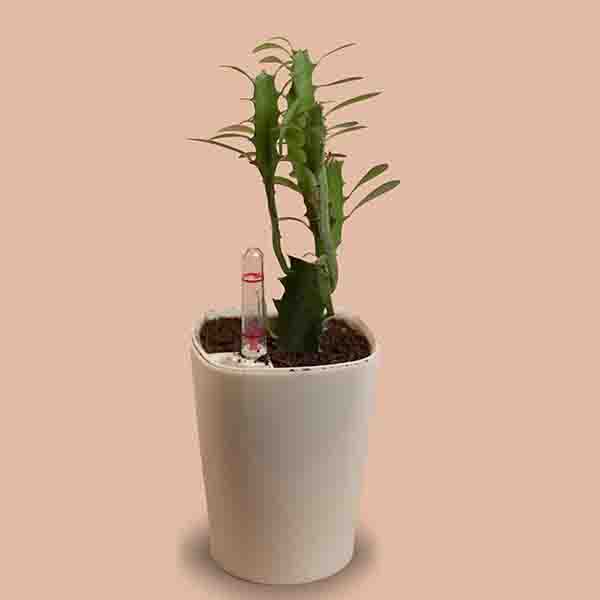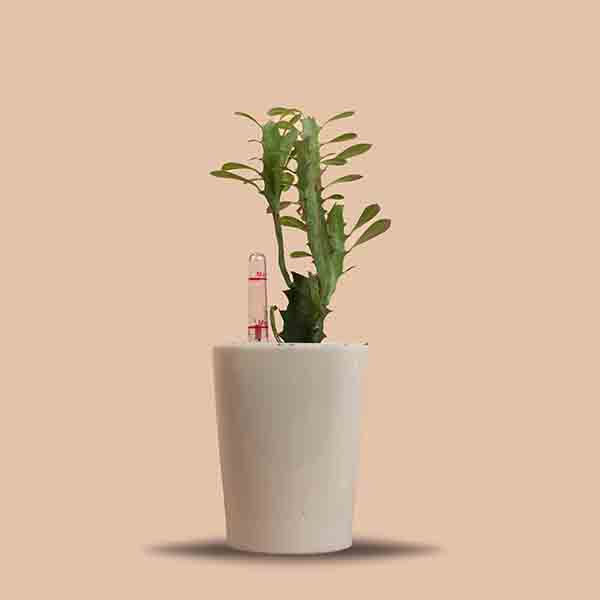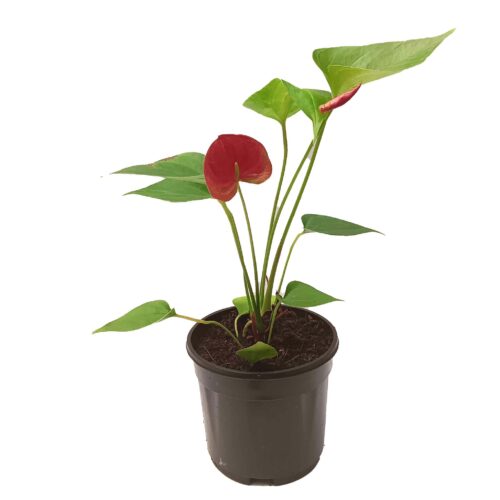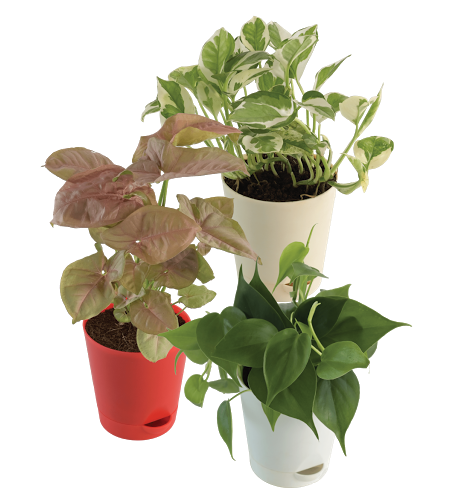Euphorbia Trigona, or the?African Milk Tree?as it’s commonly known, is a highly architectural and curious houseplant. Easy to look after, pest resistant and a fast grower means it makes the perfect specimen that adds interest to a sunny spot.
Like many in the Euphorbia genus, it’s a mix between a cactus and a succulent plant but has traits familiar with both. It’s easy to treat it like a cactus accidentally, which can cause problems for new owners, but if you follow our care guide further below, you’ll be fine.
The “Trigona” name comes from the plant’s stems which have three distinct sides creating a?Triangular?effect (if it has four sides, you may have a?Euphorbia Acrurensis?instead). As each side reaches the edge, it rounds out slightly to create a ridge. Along the ridge, two thorns will form every cm or so and in between those, a leaf will normally grow.
The leaves have a teardrop shape and tend to be present for only short periods, a growing season or two. If you provide poor care, then the leaves will be the first to drop off.
Even if you end up with a leafless stem, it’s still a striking and handsome houseplant.
You can buy two main varieties, and both are pictured in the first photo at the top of this article. The all-green variety is?E. trigona?and as this name description implies is entirely green, almost a lime green at times. You’ll get some mottled patterns on the stems but otherwise it’s pretty plain.
The other is?E. trigona?rubra?(sometimes sold as?Royal Red), which has a rich and varied colored palette. It has flushes of deep red, almost burgundy on the leaves and stems, but this coloring can become less pronounced or deeper depending on the light levels you provide.
Either way, both varieties are quite beautiful due to their structural upward growth habit and thick triangular-shaped stems.
These are less commonly sold houseplants and the struggle to find one could be real. On the plus, they’re easily propagated and grow fast, meaning they should be reasonably priced when you do come across them.
Plants sold as a single upright stem might look quite small, but?you can easily train them?into something much larger with many branches over a number of years.
Very tall, bushy and mature plants are going to cost quite a bit more as the seller will have spent quite a bit of time training and growing them on.
My recommendation is to consider buying both the all green and Rubra cultivar when they’re small and competitively priced. They grow quickly and are rewarding to watch and observe as they mature.
Euphorbia Trigona Care and Growing Guide
Light
You’ll find lots of conflicting information online. Some say put them outside and give them full direct sunlight all day long. Others say this will burn and damage the plant and will only tolerate a little sun even if grown indoors.
From our experience both pieces of advice are partly true. So our advice is as follows.
These are succulents and not true cacti, so intense pounding sun isn’t something your plant wants or will enjoy. Coming from Central Africa, they’re well adapted and expecting to deal with heat and some sun though, so they do need either bright light all day or some sunlight for an hour or two.
You can also put them outside during Summer providing the location you pick for it gets at least some partial shade.
You should not suddenly move your plant into intense sunlight if it’s been in a darker spot for a while, or you’ll risk scorching. Get them acclimatised for a week or so by moving them into the sun for an hour or so a day then back into shade again, gradually increasing the time in the sun.
They absolutely do not do well in lower light settings.?This plant needs good light levels and if you can’t give this, a grow light will be required.
If the light being received is too low, you’ll have little to no new growth. New leaves will only grow on one side of the plant and stems may also bend towards light sources rather than straight upwards.
Even plants grown in good light levels might have some of these issues if the light is only coming from one direction. If this happens, rotate the planter 1/4 turn every week or two for more consistent growth.
Watering
There are two main reasons this plant does poorly in some people’s care and that’s normally because it’s mistaken for a cactus. New owners might assume it needs as much sun as possible and that it barely needs any water. Wrong on both accounts.
We covered the light issue above already and the water needs are as follows.
Although it’s considered to be a drought-tolerant plant, they’re surprisingly quite thirsty plants, using lots of water and drying out fast in warm temperatures. Wait until the top inch or so dries completely, then water well again.
It’s likely a combination of having them in bright light and a warm room, but I’ll typically water mine once or twice a week in late Spring and throughout Summer. Once a week at the very most in Winter.
When they’re very dehydrated, you might notice the stems seem a little soft to the touch. Once well watered and about 5 hours later if you feel the stems again they will feel full and puffy.
They can be easily overwatered, so if there is any doubt whether your plant needs a top-up or not, wait a few more days to be safe.
Humidity
Almost any humidity you find in a standard home is going to be okay for these plants providing there is good air circulation. If combined with overwatering, you may run into issues with excessive humid and stale rooms, but otherwise, you don’t need to give this a second thought.
Feeding
While not overly hungry, it will still love you if you can provide a well balanced feed every few months whenever it’s in active growth. Use a standard houseplant feed or one designed for succulents and cacti.
Temperature
They prefer warmer temperatures, but will put up with some cool ones too. If temperatures are too cold, don’t expect any growth and cut back on the watering to ensure you minimize the risk of root rot.
It can survive temperatures approaching freezing if necessary, but it’s not a truly hardy plant and prolonged exposure will almost certainly cause some damage.
Repotting
Young small plants will normally be growing fast and they will need repotting once a year until they become more significant. At this point, you should be fine to repot it once every two or three years.
You’ll get significantly more visible growth compared to the space the roots need. This basically means it’s normal for larger plants to be in comparatively small containers.
The leaves and stems are easily damaged so make sure you wear protective gloves to protect yourself from the thorns and any latex sap. If you hurt your plant significantly while handling it and it’s bleeding heavily, you can run the cut section under a cold tap for a minute or two until it stops.
Whenever I repot mine, the plant seems to lose some of its natural support and becomes wobbly in its pot as the root ball can rock around.
This can be quite worrying, but after a few weeks, the soil settles down and the roots will stabilise into place again.
What kind of soil does African Milk Tree Plants need?
You can grow these plants in a wide range of growing mediums. Regular potting compost or soil, sandy soil and special mixes labeled for cacti and succulents are all fine, basically the mix should be a type of well-draining soil.
Avoid using anything too compacted or heavy such as 100% topsoil as the roots do prefer some natural drainage. Equally, remember they do like their water, so if the mix you’re using is too “open” and free-draining you’ll be watering much more frequently.
Propagation
You’ll not be able to create new plants by seed (see the “Flowers” section below to find out why), but it’s straightforward to make new plants through stem cuttings.
All you have to do is cut off a newish stem, no older than two years is best. The stems will be pretty fleshy so you’ll probably have to use a knife or pair of secateurs instead of scissors which just won’t cut it (pun).












Reviews
There are no reviews yet.